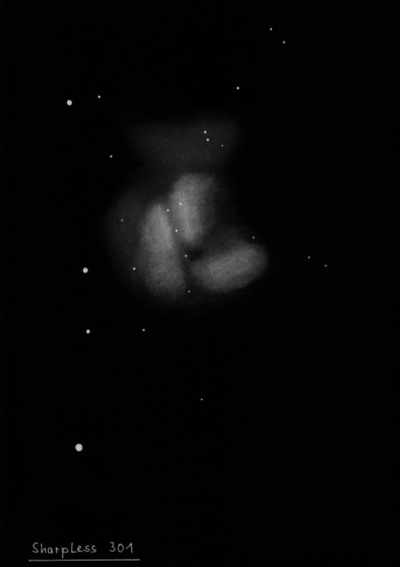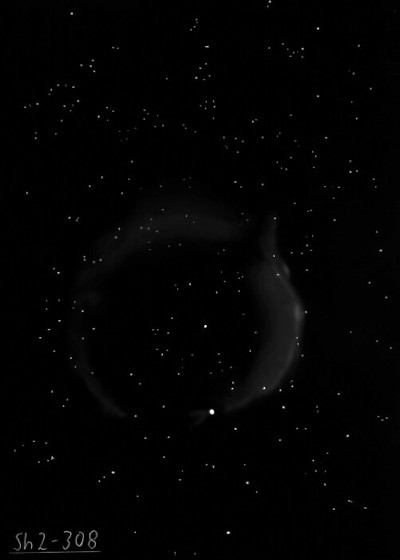A striking constellation in the southern sky, made up of bright and simply arranged stars. The constellation includes Sirius, the brightest star in the night sky. Apart from the Sun and the Moon, it is only outshined by the planets Jupiter, Saturn and Mars. Sirius is also one of the vertices of the Winter Triangle, along with Procyon of the Canis Major and the star Betelgeuse in the right arm of Orion. The constellation is not the most extensive, but neither is it somehow poor in interesting objects that become the target of many amateur astronomers. Thanks to its position in the Milky Way's winter Milky Way, the Canis Major is rich in various open clusters, of which M41 is the clear leader. It also contains several nebula complexes, a planetary nebula, and a few galaxies whose light has broken through the gas and dust clouds of the Milky Way. For binary enthusiasts, this rich region is certainly well suited. Globular clusters are not found in the constellation.
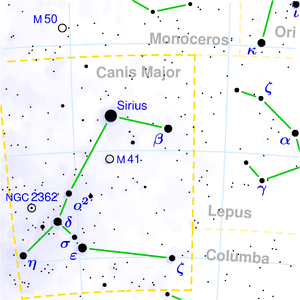
Sírius (α CMa) - The brightest star in the sky, known to almost all ancient civilizations, is Sirius. Orion's belt points towards Sirius, extending downwards. There, near the horizon, especially on cold winter nights, we can see a bright blue-white star flickering due to the restless atmosphere. After all, the Greek word "Sirios" means flickering, sparkling. Sirius has a magnitude of -1.5, but compared to other stars, it is not exceptionally luminous. It owes its brightness to its relatively close distance from us - 8.7 light-years, which ranks it fifth in the list of our closest stars (excluding companions). Its luminosity is 23 times greater, its diameter is 1.8 times larger, and its mass is 2.35 times greater than our Sun. Its surface temperature of 10,000 K gives it its blue-white color.
Adara (ε CMa) - A binary star, with its companion of magnitude 8.1 lying at a distance of 7.5" from the primary component, which has a brightness of 1.5 magnitude. Due to the large difference in their brightness, we will need a telescope with an objective diameter of at least 15 cm to resolve them.
τ CMa - A beautiful multiple star is observable even with a small telescope within the open star cluster NGC 2362. It is located in a magnificent environment filled with faint stars. The primary component is yellow with a magnitude of 4.4, while the companion is blue with a magnitude of 10.5. They are separated by 8.2".
μ CMa - In a small telescope, there is an unequally bright pair of stars in mutual contact, with a sparkling contrast of orange and blue color. In a larger telescope, we can separate them with a magnification of 175 times. The yellow component has a brightness of 5.3 magnitude, while the blue component with a brightness of 8.6 magnitude is located at a separation of 3 arcseconds. Two companions with a magnitude of 10 are located slightly further away.
17 CMa - A very beautiful multiple star, even for a small telescope! A low magnification will reveal a stunning wide triple star with a white primary component of magnitude 5.8 and two orange companions forming a right-angled triangle. In the same field of view, a companion of magnitude 9.5 and the double star π Canis Majoris are observed.
h3945 - Winter Albireo or Alamak. A beautiful double star composed of an orange 4.8 magnitude component and a blue component with a magnitude of 6.8. It can be resolved with a small telescope at a separation of 26.6".
Sírius B - In 1834, Friedrich Bessel discovered that Sirius periodically deviates from its position, which could only mean one thing: the star is accompanied by an invisible companion. However, the telescopes of that time were not able to detect it. The big event occurred three decades later, in 1862, when the American optician Alvan G. Clark, an excellent telescope designer, discovered a faint star near Sirius while testing his new 460 mm refractor, later designated as Sirius B - also known as the "Pup" in Anglo-Saxon regions. However, it was not until 1915 that its true physical nature was determined, making it the first ever discovered white dwarf.
NGC 2359
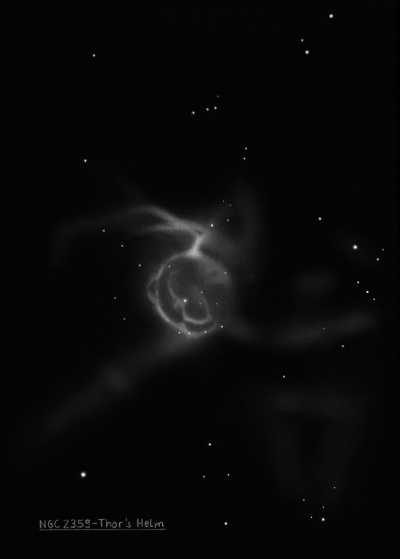
13x80mm (1/13/07): the circular central region of Thor's Helmet was easily visible at 13x in my 80mm finder using an OIII filter (24mm Panoptic), though the "horns" of the helmet were not seen.
William Herschel discovered NGC 2359 = H V-21 = h3075 on 31 Jan 1785 (sweep 363) and recorded "A broad elongated nebulosity, in the form of a parallelogram with a short ray southwards from the south preceding corner. The nebulosity between the milky and resolvable, almost of an equal brightness; but very faint. The parallelogram about 8' long and 5 or 6' broad, but ill-defined." He published a sketch in his 1811 paper (Fig. 3) as an illustration "of detached Nebulosity".
John Herschel observed this nebula from the Cape and recorded "a very singular nebula, much like the profile of a bust, (head, neck and shoulders,) or a silhouette portrait, very large, pretty well defined, light nearly uniform, about 12' diameter. In a crowded field of milky way stars, many of which are projected on it." His RA was exactly 1 minute too small (but accurate in NPD) and this position was copied into the GC and later the NGC. Howe noted this error when he observed the nebula. Herschel's sketch (Plate IV, figure 4) shows the silhouette shape well with the shoulders/bust region the brighter "wing". See notes for NGC 2361. From Malta, William Lassell sketched it similar to a balloon, with a long "neck" twisted in the southwest direction.
Joseph Turner made a more accurate sketch on 24 Jan 1876 with the Great Melbourne Telescope. The main 5' bubble is depected as annular with some interior nebulosity particularly south of the central star. The main tail was sketched accurately, though it ends before the thin streamer section. The prepared lithograph of the nebula was not published.
I'm surprised NGC 2359 is mentioned in Garrett Serviss' 1901 "Pleasures of the Telescope" written for at most 5-inch telescopes: "In [GC] 1511 we have a faint nebula remarkable for the rows of minute stars in and near it." And in the 1909 book "In Starland with a 3-inch Telescope", William Olcott repeats "Note the nebula [GC] 1511 and the curving row of faint stars near it."
Based on plate taken with the 60-inch at Mt Wilson in 1917, Pease reported: "Sir John Herschel pictured it as resembling a bust, while Lassell drew it like balloon, with a long neck twisted in the Sp direction. The balloon or head is approximately 5' in diameter; the neck is to the south, with nebulosity about 1' wide extending 8' west, concave on the north and gradually narrowing and fading out. From the top (N) of the head a symmetrical streamer concave to the south extends in the western direction...A second streamer about 1' wide extends east from the top of the head to a distance of 9'."
300/350mm - 13.1" (1/28/84): unusual emission nebula, fairly bright, fairly large, about 7'x5'. A thinner strip extends west of a mag 10.8 star on the south end. A few fainter stars are superimposed on the north side. A very faint section is also attached at the NW end extending towards the NW.
400/500mm - 17.5" (12/28/00): "Thor's Helmet" is a remarkably bright, detailed nebulosity at 100x using an OIII filter. The central region is a 5' bubble (illuminated by a Wolf-Rayet star) with a brighter rim along the west side giving a "C" appearance with irregular knots, filamentary wisps of nebulosity and areas of thinner nebulosity in the interior. A number of fainter stars are superimposed in the central region along with some brighter mag 11 stars on the north portion of the rim.
The southern "horn" of the helmet is attached at the south end of the bubble and a mag 10.5 star is attached to its SE side. The brightest portion is a thick 4' extension angling towards the WSW. As it extends more directly west it thins out into a long 10' streamer. The northern "horn" of Thor's Helmet" is attached at the northwest end of the central bubble and extends towards the northwest. This section is fairly long and thick but brighter along a thin spine. A fainter strip of nebulosity also begins on the northeast end of the central mass and extends 10' due east. Finally, weak nebulosity was also visible to the southeast of the central "helmet". Illuminated by the Wolf-Rayet star HD 56925 = WR 7.
900/1200mm - 48" (4/13/10): the 5' central region of Thor's Helmet was mesmerizing at 267x and 330x (unfiltered). A large, bright knot is at the south end of the rim where the inner portion of the bright wing that heads southwest connects with the central bubble. Along the northern edge of the rim are three collinear mag 11 stars (2.2' length) oriented E-W. The rim of the bubble is noticeably brighter in a thin arc beginning due north of center (between the two western stars) and extending about 90° clockwise to the west (this portion of Thor's Helmet was catalogued separately as NGC 2361). The rim is also brighter along a 45° thicker arc on the southeast side. The rim has a lower surface brightness on the east and NE side and varies in thickness and brightness around the entire bubble.
Three brighter stars (nearly collinear) and several fainter stars are superimposed within the main bubble. A second, smaller, incomplete bubble just north of center outlines an inner dark "hole", which includes one of the brighter stars. The 11.4-magnitude ionizing Wolf-Rayet star HD 56925 is at the southwest edge of this inner bubble. Additional thin wisps of nebulosity criss-cross the central region.
Notes by Steve Gottlieb
NGC 2362
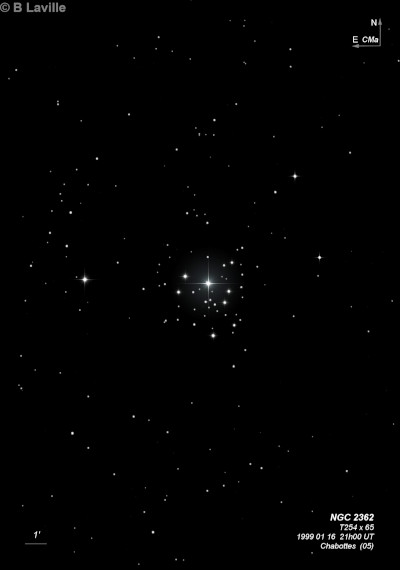
Giovanni Hodierna probably discovered NGC 2362 = H VII-17 = h441 = h3077 around 1654 (marked on a map of Canis Major). It was discovered again by William Herschel on 4 Mar 1783 before starting his sweeps, with his 6.2-inch reflector. He found it again on 6 Mar 1785 (sweep 381) and described it as "a most beautiful cluster of pretty large stars with one of the 7th magnitude in the center, which however I suppose does not belong to it." John Herschel observed the cluster from both Slough and the Cape of Good Hope, where he recorded "a fine cluster of discrete stars, 60 or 70 in number. R, gbM, 8' diameter." It's surprising this bright cluster wasn't found by one of Messier's contemporaries.
300/350mm - 13.1" (1/30/06 - Costa Rica): gorgeous low power field surrounding Tau CMa using the 20 Nagler (75x). Tau was easily resolved into a triple with two mag 10 and 11.2 companions at 8.5" and 14" to the east. At 170x, 75-80 stars are visible and the cluster appears fully resolved. A string of stars passes to the north of Tau oriented NW to SE. Several faint stars and a detached clump lie to the north of Tau beyond the string. A mag 8.5 star marks the south border of the cluster.
13.1" (2/18/04 - Costa Rica): stunning open cluster at 105x surrounding Tau Canis Majoris which is a very close triple star. Perhaps 75 stars are resolved in a well-detached 6' region.
13.1" 50 stars in a triangular-shape surrounding Tau Canis Majoris, very rich, impressive.
400/500mm - 17.5" (3/2/02): at 100x, this is a gorgeous, uniformly rich cluster surrounding Tau CMa, which is offset north of center. A WNW-ESE string of stars north of Tau gives a flattened border and the rich southern portion tapers to the south giving a triangular appearance. At 220x, ~60 stars are visible in a 6' diameter, many of 10.5-11. Just following the central star to the ESE are two mag 11 companions. Several other fainter stars are in the central core including one fairly close preceding.
17.5" (2/28/87): about 75 stars in 6' diameter surrounding Tau Canis Majoris (V = 4.4) in an unusually rich, impressive cluster! Tau is resolved into several components.
Notes by Steve Gottlieb
M 41
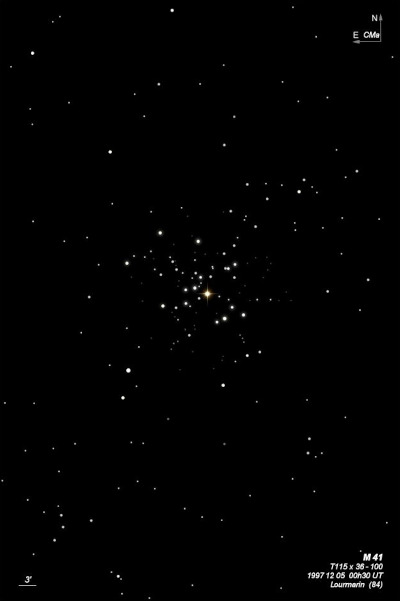
Giovanni Hodierna discovered M41 = NGC 2287 = h411 in 1654, using a small refractor at 20x. It was independently discovered by John Flamsteed on 16 Feb 1702: "Near this star (12 CMa), there is a cluster." Le Gentil also found it in 1749. Wolfgang Steinicke credits Aristotle with a naked-eye discovery about 325 based on comments by J.E. Gore in his 1902 review of the Messier objects. But the source material is not very reliable. See http://seds.org/messier/more/m041_ari.html for this possibility.
William Herschel recorded M41 in 1784 as "A large cluster of very coarsely scattered large [bright] stars." and in Mar 1830 John Herschel called M41 "Coarse; fills field. The chief, 8m, is red; a poor cluster." The position in the NGC, RNGC and NGC 2000 is 1 tmin of RA too far east.
200/250mm - 8" (10/4/80): ~60 stars mag 7-11.5, very bright, very large, very rich, includes 10 bright stars mag 7 and 8. Many of the stars are arranged in curving rows and groups, includes several double stars. Located about 20' NW of mag 6.0 12 Canis Majoris. Naked-eye object in dark sky.
400/500mm - 18" (2/14/10): this naked-eye cluster was perfectly framed at 73x with the 31mm Nagler (67' field). M41 extends roughly 35' in diameter though many of the brighter mag 7 and 8 stars are in a smaller central region. The cluster includes roughly a dozen brighter stars, many forming a large central oval ~15'-20' diameter and elongated E-W or SW-NE. Near the center is a richer grouping with a number of fainter stars and two bright stars including orange (K3-class) mag 6.9 HD 49091 (brightest member).
A number of loops and chains appear to spin out from the central grouping. One long chain extends NNW to the edge of the cluster and a shorter nearby chain heads WNW and includes a pretty equal mag pair before bending abruptly SW. Two other chains extend from the center to the SW and ENE. About 20' SE of the center of the cluster is mag 6.1 HD 49333, the brightest star in the field though not a member.
Naked-eye - (numerous times): fairly easy naked-eye glow in a dark sky.
Notes by Steve Gottlieb
NGC 2354
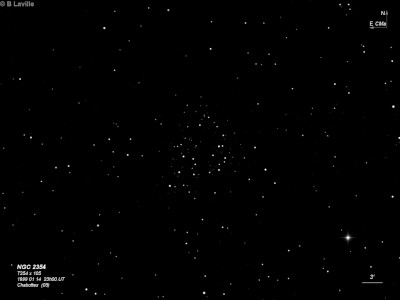
William Herschel discovered NGC 2354 = H VII-16 = h438 on 6 Mar 1785 (sweep 381) and called it "a large cluster of scattered stars, considerably rich, about 20' in diameter or more." His position matches this cluster. John Herschel recorded on 7 Jan 1831 (sweep 317), "loose straggling cl; the preceding part is rather separated from the following, and more comp. Place that of 3 stars in the following part."
400/500mm - 17.5" (3/12/94): ~100 stars in a 20' diameter, circular outline, fairly uniform in magnitudes. There are no prominent subgroups or individual stars but the cluster is fairly detached in the field at 100x. Unconcentrated with a 9'x3' void or dark lane in the center elongated N-S. A double star with components 11.5/12.5 at 14" separation is just following the dark lane towards the south end.
Notes by Steve Gottlieb
NGC 2360
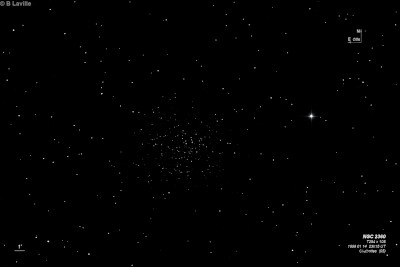
Caroline Herschel discovered NGC 2360 = H VII-12 = h440 = h3076 on 26 Feb 1783. NGC 2360 was her first deep sky discovery and occurred before William had begun his sweeps for nebulae. Perhaps this discovery, along with M93, which she discovered independently earlier that night (and assumed it was new), inspired her brother to search for nebulae starting the next month.
On 4 Feb 1785 (sweep 366) William recorded "a large cluster of pretty compressed scattered stars, near 1/2° in diam, considerably rich, most of the stars of the same size." On 31 Dec 1785 (sweep 503) he wrote, "A beautiful cluster of pretty compressed stars, very large." John Herschel recorded it from the Cape of Good Hope on 12 Feb 1836 as the "Middle of a fine large, rich cluster, not compressed to the middle. Stars 9..12th mag; fills field."
300/350mm - 13.1" (1/28/84): includes about 40 fainter stars in an elongated, arrowhead shape with mag 9 SAO 152691 at the east edge (probably a foreground star). Appears rich with fairly uniform magnitudes.
Notes by Steve Gottlieb
NGC 2345
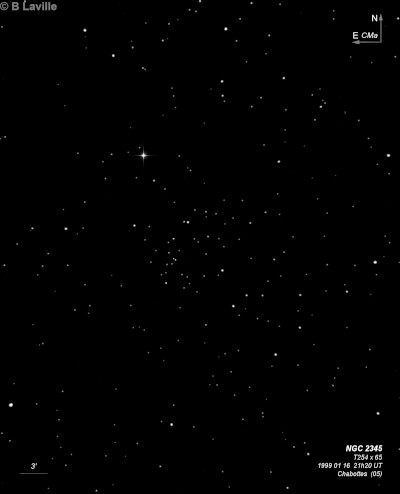
John Herschel discovered NGC 2345 = h3073 on 14 Feb 1836 and recorded "a pretty rich cluster; irregular fig; 7' diam; gbM; stars 10..14 m; place that of a double star, the chief *." His position corresponds with HJ 3930 = 9.7/10.6 at 15".
400/500mm - 17.5" (3/20/93): 50 stars mag 9-14 in 10'x8' region elongated SW-NE. Fairly rich in faint stars. Includes the pretty double h3930 = 9.7/10.6 at 15" on the north side. Near the center is a small clump of about 8 stars including an unequal triple star. Located midway between mag 8 SAO 152444 6' NNE and a mag 9.5 star 6' S.
Notes by Steve Gottlieb
IC 2165
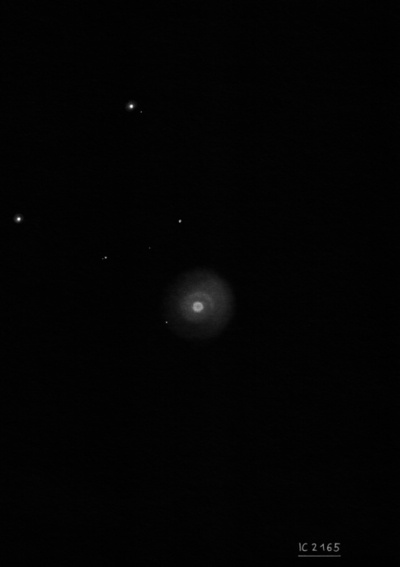
Williamina Fleming discovered IC 2165 = Fleming 79 on a Harvard objective prism plate taken in 1898 with the Bache 8-inch telescope.
Based on Crossley photographs, Curtis (1918) reported IC 2165 as, "a minute oval disk 9"x7" in pa 81°. The disc of of nearly equal brightness throughout, but with just a trace of ring structure, and shows slightly brighter along the major axis."
200/250mm - 8" (12/6/80): stellar at low power. Definite disc seen at 220x, bluish, slightly elongated.
300/350mm - 13.1" (1/11/86): at 88x appears bright, very small, just non-stellar, slightly bluish color. Takes 360x and appears slightly elongated E-W. No central star visible, fuzzy edges to the bright oval disc. Located 38' W of ∑903 = 6.1/10.8 at 23".
400/500mm - 17.5" (12/28/00): at 220x appears as a bright, compact, high surface brightness disc with a bluish color. Crisp-edged at 380x and slightly elongated but no central star seen (mag 17.9).
Notes by Steve Gottlieb
NGC 2207
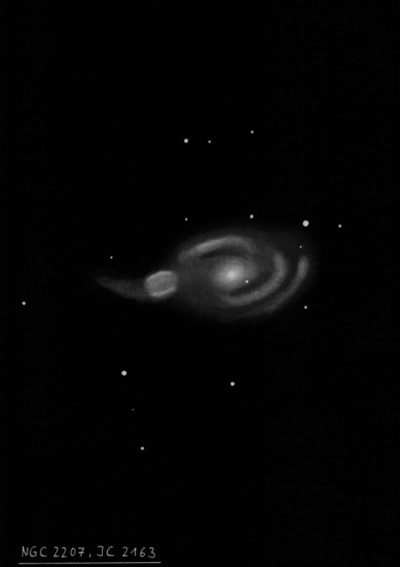
John Herschel discovered NGC 2207 = h3032 on 24 Jan 1835 and recorded "pB, pL, mE in pos = +/- 87°, pslbM, 2.5' long, 40" broad, to a tolerably well defined round nucleus." His position and Engelhardt's micrometric measurement are accurate, though I'm surprised that Herschel wasn't able to resolve the IC component of the system.
Joseph Turner observed this interacting pair on 18 Dec 1878 with the 48" Melbourne Telescope. He wrote, "It appears to consist of two nebulae" and his sketch clearly shows IC 2163 elongated E-W as a separate object to the east. He noted "the preceding one [NGC 2207] seems to have [three?] distinct nuclei or perhaps [three?] small stars." Herbert Howe also resolved the pair on on 11 Feb 1898 with the 20" refractor at Denver and was credited with the visual discovery of IC 2163. Holmberg 85b refers to the inner spiral arm (ring) to the west of the core.
300/350mm - 13.1" (1/28/84): moderately bright, moderately large, bright core, double nuclei. A faint extension is visible to the east. This is an unusual interacting pair and the extension to the east is IC 2163.
400/500mm - 18" (2/5/11): fairly bright, fairly large, sharply concentrated with a bright, elongated core (WSW-ENE) ~1' diameter and a large, much lower surface brightness halo ~2.5'x2.0'. A faint star is close WSW of the nucleus. A mag 13.5 star is at the NW edge of the halo.
Forms an interacting pair with IC 2163, which is embedded on the east side of the halo. The fainter companion appears fairly faint, moderately large, oval E-W, 1.0'x0.7', weakly concentrated
900/1200mm - 48" (2/20/12 and 2/28/19): this beautiful spiral galaxy forms a stunning pair with IC 2163 attached to its east side. The center is sharply concentrated with a brilliant nucleus embedded in a very bright core. A mag 13.5 star is superimposed on the west-southwest edge of the core. A couple of beautiful, winding spiral arms are visible in the halo. An outer arm on the south end of the galaxy stretched to the west and curved counterclockwise north towards a mag 12.5-13 star situated 1.7' NW of center. A second more inner arm vaguely emerged on the west side of the core and wrapped counterclockwise to the north, where it was parallel to the outer arm described above. This arm then curved back east along the north side of the halo, stretching to the NE side of the halo, but not reaching IC 2163. The region between the core and these arms were noticeably darker due to dust. IC 2163 is attached at the east side of NGC 2207. The central region was very bright, round, ~1' diameter, small bright core. A surprisingly prominent spiral arm is attached on the southwest side. It sweeps gracefully to the east and bends gently clockwise. This arm was ~1.5' long and significantly increased the overall size to roughly 2'x1'. Just northeast of the tip of the arm is 2MASX J06163579-2122032, which appeared as a faint, very small knot. The 2MASX galaxy is probably a dwarf elliptical at the same distance as the pair.
Notes by Steve Gottlieb
NGC 2367
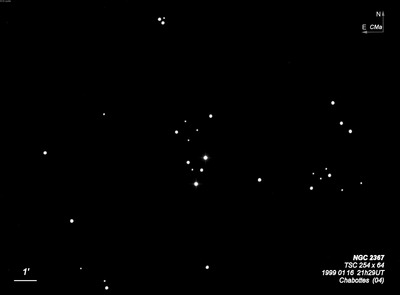
William Herschel discovered NGC 2367 = H VIII-27 on 20 Nov 1784 (sweep 326) and recorded "a small cluster of scattered stars, not rich, nor very compressed." His position is ~3' south of the center of this compact cluster.
400/500mm - 17.5" 25 stars in a distinctive, fairly rich 6' group which is elongated N-S. The brightest star HD 57370 is a close double (HLD 87 = 9.4/9.7 at 5"). A nice elongated group at the south end includes the bright double, three other mag 11/12 stars and several fainter stars. A compact group of four stars is in the field to the north. Located in a rich low power field at 100x.
Notes by Steve Gottlieb
NGC 2383
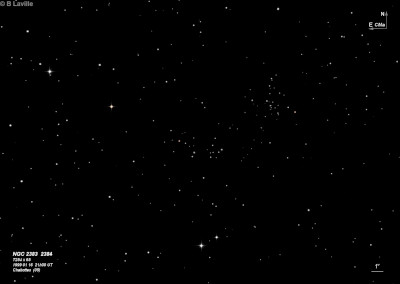
John Herschel discovered NGC 2383 = h3081 on 15 Feb 1836 (along with NGC 2384 = h3083) and recorded "cluster, irregularly round, pretty much compressed, 6'. Stars of mixed magnitudes." His first position (of two) is accurate.
200/250mm - 8" (3/28/81): small, rich cluster of mag 11-13 stars, three mag 10 stars are near, NGC 2384 lies 8' SSE.
400/500mm - 17.5" (3/7/92): about 30 stars mag 10-14 in 5' diameter and rich in mag 13-14 stars near the center. Includes three mag 10 stars; one at the west end, another just east of center and the last at the east end. Just SW of the mag 10 star near the center is a rich glowing knot which is very pretty with averted. The cluster is set over unresolved background haze. NGC 2384 is in the field 8' SE.
Notes by Steve Gottlieb
NGC 2217
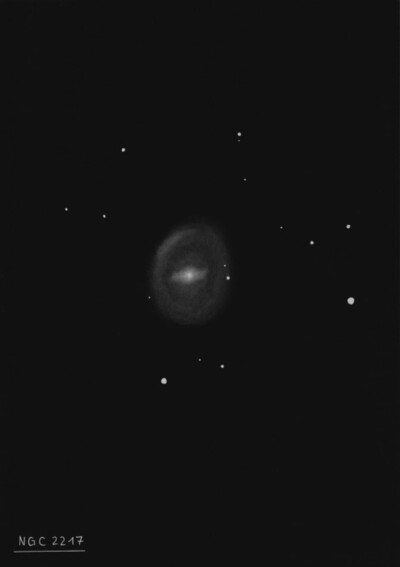
John Herschel discovered NGC 2217 = h3041 on 20 Jan 1835 and recorded "vB; R; psmbM; 30", r." His position (measured on two sweeps) matches ESO 489-042 = PGC 18883.
300/350mm - 13.1" (1/18/85): fairly bright, small, elongated ~E-W, well concentrated with a bright core surrounded by small faint halo, stellar nucleus at moments.
600/800mm - 24" (2/5/13): very bright, very large, contains a brighter 1.3' core that is sharply concentrated with an intense nucleus! The round halo extends 3' and has a fairly smooth surface brightness. The outer halo passes through a wide pair of mag 12/13 stars on the west side. UGCA 126, a thin edge-on, lies 60' WSW.
Notes by Steve Gottlieb
NGC 2292
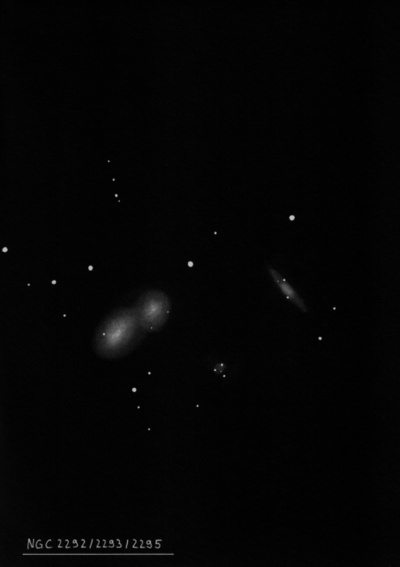
John Herschel discovered NGC 2292 = h3063 on 2 Feb 1835 and described "a double nebula [with NGC 2293], the preceding eF; the following (whose place is here set down) pB; both R gbM; in a field full of stars, among which is also a third nebula." His description clearly refers to the double system VV 178 = ESO 490-048/049, although he reversed the orientation and position with NGC 2295! Herbert Howe was the first to note this error in 1898 and corrected the orientation and positions based on observations with the 20" refractor at the Chamberlin Observatory in Denver.
400/500mm - 17.5" (1/20/90): very faint, very small, round, low even surface brightness. Forms a close pair with NGC 2293 1' SE and a trio including NGC 2295 just 4' W.
Notes by Steve Gottlieb
NGC 2325
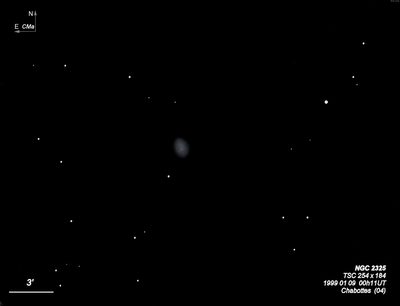
John Herschel discovered NGC 2325 = h3071 on 1 Feb 1837 and recorded "pB; pL; lE; gbM; r; 2' long." His position (single sweep) matches ESO 427-028 = PGC 20047.
Joseph Turner's sketch, made on 5 Jan 1877 with the Great Melbourne Telescope (unpublished plate V, figure 38), depicts it very elongated N-S. Baracchi's sketch on 11 March 1885 added a star at the south tip (called 16th mag)
300/350mm - 13.1" (3/3/84): fairly faint, fairly small, elongated N-S. A mag 12 star is off the SE edge 1.6' from center. Located in a rich star field.
Notes by Steve Gottlieb
NGC 2263
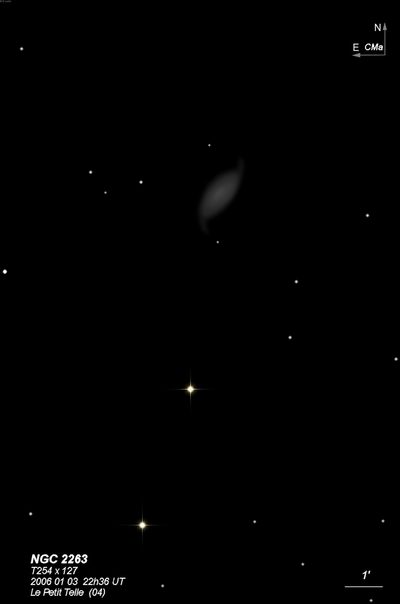
John Herschel discovered NGC 2263 = h3058 on 20 Jan 1835 and recorded "Not vF, R, or lE, pslbM, E between two vS stars, and has two stars about 8th mag S.p. pointing to it." His description and coordinates matches ESO 490-019 = PGC 19355, though the two bright stars are south following.
400/500mm - 17.5" (1/20/90): fairly faint, fairly small, oval NW-SE, even surface brightness. Situated between two mag 13.5 stars 1' N and 1' S with a similar star 1.7' ENE. Located 4.2' N of mag 8.5 SAO 172076 and 7.2' NNW of mag 9.0 SAO 172078" (nearly collinear with the galaxy).
Notes by Steve Gottlieb
NGC 2384
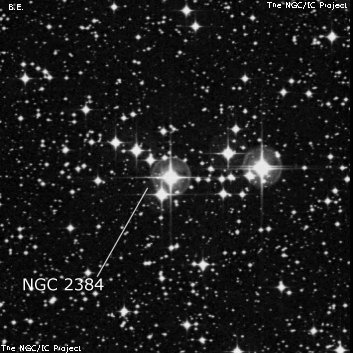
John Herschel discovered NGC 2384 = h3083 on 15 Feb 1836 and described as "a cluster composed to two groups of bright stars separated in RA by a dark interval. Chief star of preceding group taken." His position (measured on two sweeps) is accurate.
200/250mm - 8" small group, including 9.0/9.6 at 5".
400/500mm - 17.5" (3/7/92): about 20 stars mag 9-14 in an elongated E-W group about 5' length. Includes the close bright double star h3964 = 9.0/9.7 at 5" near the center. A mag 9 star is at the west end and close east are two mag 11/12 stars and a group of six fainter stars. The rest of the cluster mainly consists of a string of six brighter stars oriented SW-NE with h3964 at the SW end of this string and a mag 10 star 30" SSE. In the same field with richer NGC 2383 8' NW.
Notes by Steve Gottlieb
NGC 2374
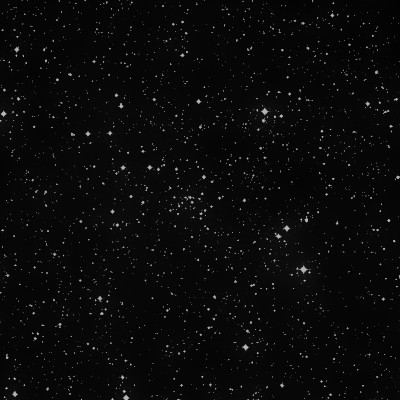
William Herschel discovered NGC 2374 = H VIII-35 = h3080 on 31 Jan 1785 (sweep 363) and recorded (summary from 3 sweeps) "a cluster of pretty large scattered stars, pretty rich, about 20' long, crooked figure." JH observed it from the Cape of Good Hope and recorded "the most compressed part of a scattered cluster or rather region, more crowded with stars than the rest of the milky way, though hardly entitled to rank as a cluster. The stars run in singular lines and curves on a dark ground."
400/500mm - 17.5" (3/12/94): ~50-60 stars in 7'x4' region elongated SW-NE. Located in a rich star field so the cluster does not have a distinct border. A detached group with four brighter mag 10-11 stars is off the NE end. The richest portion is 3'-4' diameter at the SW end and consists of three dozen stars over some unresolved haze. At the SW edge is a nice curving U-shaped group of 9 stars mag 13 that is open to the SW.
Notes by Steve Gottlieb
NGC 2204
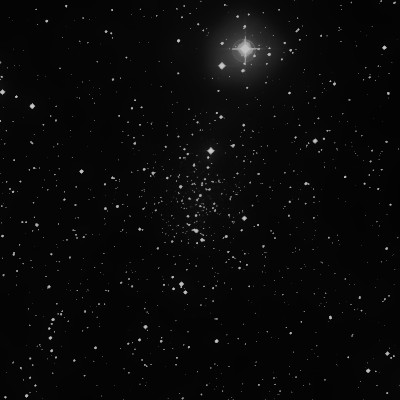
William Herschel discovered NGC 2204 = H VII-13 on 6 Feb 1785 (sweep 367) and recorded "a cluster of scattered stars, not very rich, above 15' diameter, south following a star 6-7 mag." Due to a transcrption error by Caroline Herschel while preparing her brother's first catalogue for the printer, she was credited with the discovery instead of H. VII-12 = NGC 2360. Jane Houston Jones mistakenly credited Caroline Herschel for the discovery of NGC 2204 in her Sky & Tel article on Caroline Herschel.
300/350mm - 13.1" (1/28/84): two dozen stars mag 12-14 in a 10' diameter. Two mag 9 stars are on the SW and NW edge and many stars are aligned in strings. Mag 6.0 SAO 151274 in field to NNW about 11'.
Notes by Steve Gottlieb
NGC 2243
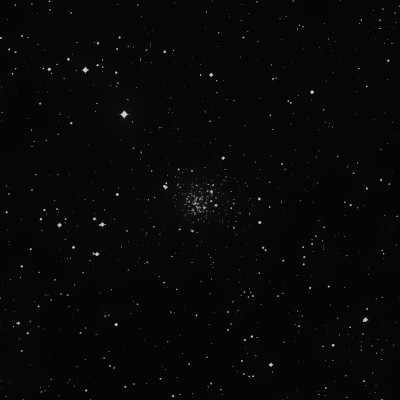
John Herschel discovered NGC 2243 = h3053 on 19 Oct 1835 and recorded "pB, R, vglbM, all evidently resolved into stars, not very rich. Something between a cluster and a globular cluster. [This ob makes the RA 24m 8.9s, but it is pretty clear that this is a misreading of the chronometer.]" On a second sweep he logged "pB, R, gbM, 4' diameter, mottled or resolved, amongst bright stars." His mean position (two sweeps) matches this cluster.
James Dunlop possibly discovered the cluster earlier on 24 May 1826. His entry for D 616 reads "an ill-defined faint nebulosity of some considerable extent, with several small stars scattered in it." Although his description seems appropriate (though I don't believe he could have resolved stars in it), his position is 33' to the east-southeast.
300/350mm - 13.1" (1/18/85): fairly small faint cluster located just 8' SW of mag 7.4 SAO 196879. Consists of unresolved haze except for four stars on the west edge and a few stars on the east edge.
Notes by Steve Gottlieb
M 3-1
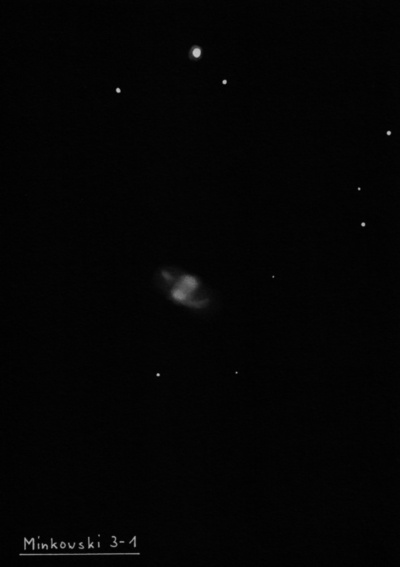
| Type | PN [?(6)] |
| RA | 07:02:49.9 |
| Dec | -31:35:29.0 |
| major_axis | 30.0'' |
| minor_axis | 18.0'' |
| position_angle | 3.0 |
| mag | 12.2 |
| surface_bright | 10.0 |
M 1-13
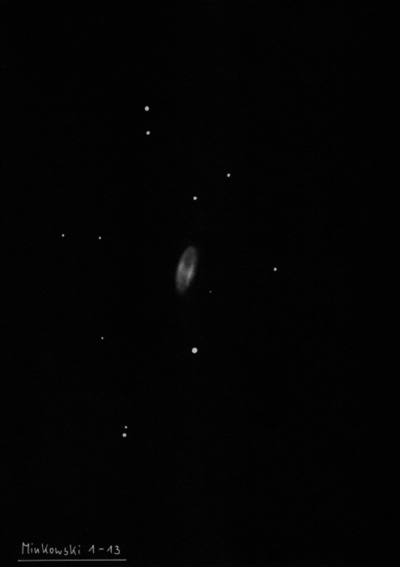
| Type | PN |
| RA | 07:21:15.0 |
| Dec | -18:08:35.0 |
| major_axis | 42.0'' |
| minor_axis | 30.0'' |
| mag | 12.6 |
| surface_bright | 11.2 |
PB 1
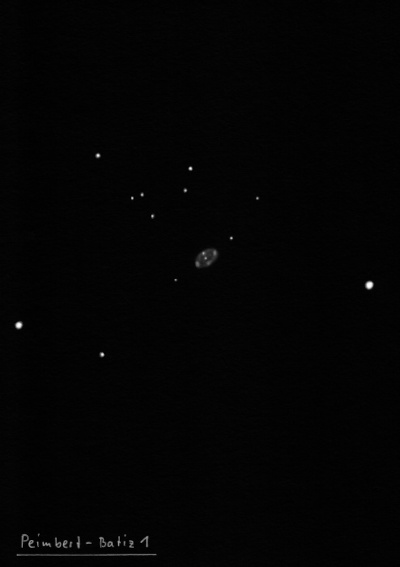
| Type | PN |
| RA | 07:02:46.8 |
| Dec | -13:42:34.0 |
| major_axis | 12.0'' |
| mag | 13.3 |
| surface_bright | 9.1 |
Abell 15
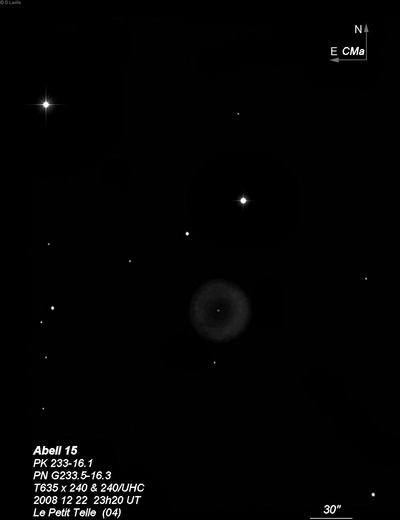
| Type | PN |
| RA | 06:27:02.0 |
| Dec | -25:22:50.0 |
| major_axis | 36.0'' |
| mag | 16.3 |
| surface_bright | 14.8 |
